
Tephrocactus articulatus (var. papyracanthus) (Paper Spine Cactus) on 7-19-16, #274-67.
Paper Spine Cactus
Tephrocactus articulatus var. papyracanthus
tef-roh-KAK-tus ar-tik-oo-LAH-tus (ar-tik-yoo-LAH-tus) pap-i-ra-kan-thus
Syn. of
Tephrocactus articulatus
Synonyms of Tephrocactus articulatus (47) (Updated on 12-10-23 from Plants of the World Online): Cereus articulatus Pfeiff. , Cereus polymorphus C.F.Först., Cereus syringscanthus Pfeiff., Opuntia andicola Pfeiff., Opuntia andicola var. fulvispina Lem., Opuntia articulata (Pfeiff.) D.R.Hunt, Opuntia articulata Otto, Opuntia calva Lem., Opuntia diademata Lem., Opuntia diademata var. calva (Lem.) F.A.C.Weber ex K.Schum., Opuntia diademata var. inermis Speg., Opuntia diademata var. oligacantha Speg., Opuntia diademata var. polyacantha Speg., Opuntia glomerata var. calva (Lem.) G.D.Rowley, Opuntia glomerata var. inermis (Speg.) G.D.Rowley, Opuntia glomerata f. papyracantha (Phil.) Castell., Opuntia glomerata var. polycantha (Speg.) G.D.Rowley, Opuntia papyracantha Phil., Opuntia papyracantha K.Schum., Opuntia polymorpha Pfeiff., Opuntia strobiliformis A.Berger, Opuntia syringacantha (Pfeiff.) C.F.Först., Opuntia turpinii Lem., Opuntia turpinii var. polymorpha Salm-Dyck, Tephrocactus andicola (Pfeiff.) Lem., Tephrocactus articulatus var. calvus (Lem.) Backeb., Tephrocactus articulatus var. diadematus (Lem.) Backeb., Tephrocactus articulatus var. inermis (Speg.) Backeb., Tephrocactus articulatus var. oligacanthus (Speg.) Backeb., Tephrocactus articulatus var. papyracanthus (Phil.) Backeb., Tephrocactus articulatus f. papyracanthus (Phil.) Guiggi & Verloove, Tephrocactus articulatus var. polyacanthus (Speg.) Backeb., Tephrocactus articulatus f. syringacanthus (Pfeiff.) F.Ritter, Tephrocactus articulatus var. syringacanthus (Pfeiff.) Backeb., Tephrocactus calvus (Lem.) Lem., Tephrocactus diadematus (Lem.) Lem., Tephrocactus diadematus var. calvus (Lem.) Backeb., Tephrocactus glomeratus var. andicola (Pfeiff.) Backeb., Tephrocactus glomeratus var. fulvispinus (Lem.) Backeb., Tephrocactus glomeratus var. inermis Speg., Tephrocactus inermis (Speg.) Backeb., Tephrocactus neoglomeratus var. andicola (Pfeiff.) Y.Itô, Tephrocactus neoglomeratus var. fulvispinus (Lem.) Y.Itô, Tephrocactus strobiliformis (A.Berger) Backeb., Tephrocactus turpinii (Lem.) Lem.
Tephrocactus articulatus (Pfeiff.) Backeb. is the accepted scientific name for this species. It was named and described as such by Carl Backeberg in Cactus (Paris) in 1953. It was first named Cereus articulatus by Louis (Ludwig) Karl George Pfeiffer and documented in Enumeratio Diagnostica Cactearum in 1837.
Tephrocactus articulatus var. papyracanthus (Phil.) Backeb. was first described by Carl Backeberg in the same publication as the species. It was first named and described as Opuntia papyracantha by Rudolph Amandus Philippi in Gartenflora in 1872. Plants of the World Online lists Tephrocactus articulatus var. papyracanthus as a synonym of the species. You can still use the name since it is validly published. 🙂
The genus, Tephrocactus Lem., was named and described by (Antoine) Charles Lemaire in Les Cactées Histoire in 1868.
As of 12-10-23 when this page was last updated, Plants of the World Online by Kew lists 10 accepted species of Tephrocactus. It is a member of the plant family Cactaceae with 150 genera. Those numbers could change as updates are made on POWO.
THERE ARE A FEW LINKS AND GROWING RECOMMENDATIONS AT THE BOTTOM OF THE PAGE FOR FURTHER READING.

Tephrocactus articulatus var. papyracanthus (Paper Spine Cactus) as I brought it home on 2-9-16.
When I was at Walmart buying cactus on February 9, 2016, a piece fell off of a Paper Spine Cactus. I just had to rescue it and bring it home. That is better than it being thrown in the trash, right? As you can see in the first photo, it didn’t take long for this little nubbin to start growing.
<<<<2017>>>>

Tephrocactus articulatus var. papyracanthus (Paper Spine Cactus) on 5-31-17, #339-43.
The Tehprocactus articulatus var. papyracanthus is native to Catamarca, Cordoba, La Rioja, Mendoza, Salta, San Luis, and Santiago del Estero in western Argentina. There isn’t much online about this cactus but is very easy to grow and very interesting for sure…
Even though the variety name is now a synonym of Tephrocactus articulatus, I am still using it because that’s what it is. There are several varieties of the species that have different features. All are synonyms of the species now.
<<<<2018>>>>

Tephrocactus articulatus var. papyracanthus on 4-8-18, #423-32.
This cactus is very carefree and easy to grow. The species can be variable, some having spines and some do not. The one I have does have a few spines as well as tiny glochids that are very hard to remove when they get in your fingers. These plants don’t get very tall because the segments are loosely attached and fall off easily then they take root and grow another plant. The feature of this variety is the papery spines rather than needles. They produce yellow or white flowers.

Tephrocactus articulatus var. papyracanthus on 5-18-18, #444-27.
They like bright light and the stems will be thinner if not given enough. If the segments fall off, just stick the end in the soil and they will easily grow a new plant. In the wild, this allows them to grow large colonies.

Tephrocactus articulatus var. papyracanthus on 5-25-18, #448-22.
I have had this cactus in this very small pot since I brought it home and decided it was time to put it in a larger pot on May 25.

Tephrocactus articulatus var. papyracanthus on 7-29-18, #487-98.
I moved most of the potted plants to the front and back porch on July 4 after the Japanese Beetle invasion. I think all of the cacti are on the back porch in full sun except the Tephrocactus articulatus var. papyracanthus. It seems to burn very easily in too much sun although it likes bright light. GEEZ!

Tephrocactus articulatus var. papyracanthus on 8-18-18, #498-7.
It does like its larger pot but I think it is looking for somewhere to drop a segment or two…

Tephrocactus articulatus var. papyracanthus on 10-10-18, #519-66.
I had to move the potted plants inside for the winter on October 10 because the forecast was calling for an “F” in a few days and the nighttime temperatures were getting cooler. I usually measure the cactus and succulents when I bring them inside but I have never measured this plant.
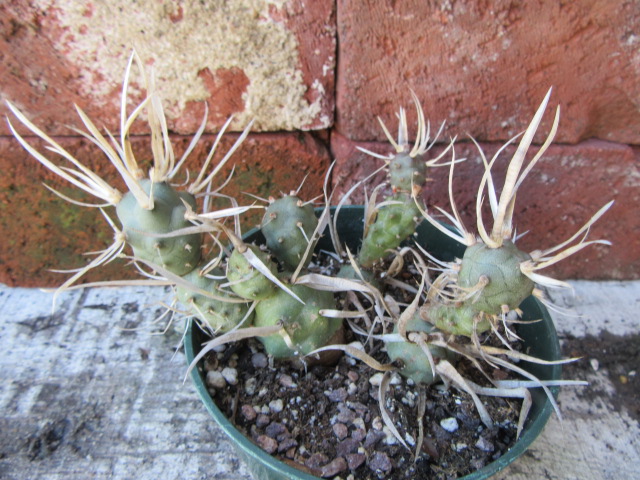
Tephrocactus articulatus var. papyracanthus on 11-29-18, #534-34.
November 29 was a nice spring-like day, so I took the cactus to the back porch for a photoshoot. I was working on a post to show the difference between the cactus in my collection.
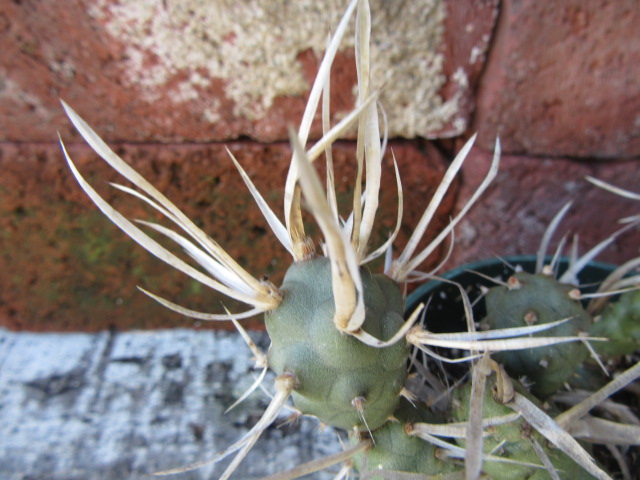
Tephrocactus articulatus var. papyracanthus spines on 11-29-18, #534-35.
The segments of this plant are loosely attached and fall off easily.
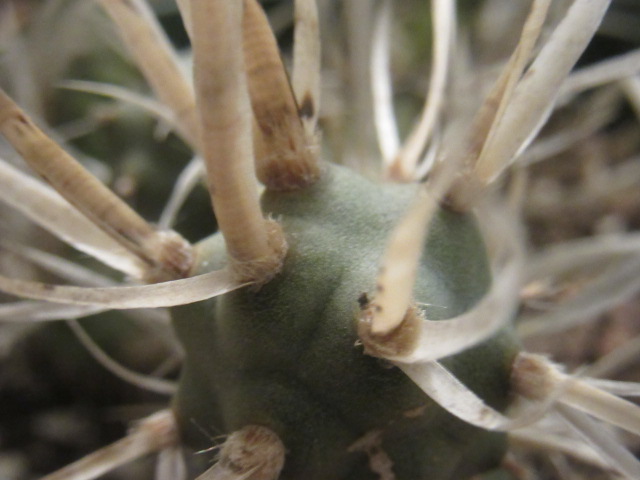
Tephrocactus articulatus var. papyracanthus close-up on 12-1-18, #535-25.
The areoles produce these strange ‘raffia-like” spines which is where the common name of this variety comes from. This plant has slightly raised tubercles but there is also a “tubercled type” of this variety whose tubercles are even more raised. These cactus areoles produce tiny glochids which differ from the wool in Mammillaria species. Glochids, which are also produced by Opuntia species (Prickly Pear) are a real pain to remove if you get them stuck in your fingers. Well, this species was once an Opuntia species…
<<<<2019>>>>

Tephrocactus articulatus var. papyracanthus on 6-16-19, #591-42.
I moved the potted plants back outside the first part of May as temperatures warmed up enough. I keep this Tephrocactus on the front porch with most of the succulents while most of the other cactus are on the back porch. I keep this cactus on the front porch because I don’t want the cats knocking the segments off… It seemed like it got sunburned before, too. They are supposed to do better in full sun and the base of the segments may be thicker so they don’t fall off as easily… Hmmm…

Tephrocactus articulatus var. papyracanthus on 6-22-19, #593-44.
LOOKING GREAT on June 22, 2019!

Tephrocactus articulatus var. papyracanthus on 10-11-19, #639-91.
I had to move the potted plants inside for the winter on October 10 because an “F” was in the forecast. I always take photos of all the plants when I move them inside and measure the cactus and some of the succulents. No point in measuring this cactus as sometimes the segments fall off… I was surprised some of the segments had gotten as tall as they were.
<<<<2020>>>>

Tephrocactus articulatus var. papyracanthus (Paper Spine Cactus) on 10-15-20, #747-102.
I had to bring the potted plants inside for the winter on October 15 because an “F” was in the forecast. As always, I take photographs and measurements as I bring them inside. The Tephocactus articulatus var. papyracanthus did very well over the summer. I don’t measure this cactus when I bring it inside because of the way it grows. For grins, I did measure the tallest, umm, stem when I put these photos on this page. It is the one on the left and it was 3″ tall and the lowest and largest segment was about 1 1/2″ wide. You have to be careful when handling this species because it will fall apart easily (not to mention the tiny glochids will stick in your fingers). To think I started out with one small segment in 2016…

Tephrocactus articulatus var. papyracanthus (Paper Spine Cactus) on 10-15-20, #747-103.
Well, the above photo didn’t come out that great but you can see the tubercles and the glochids fairly well…

Tephrocactus articulatus var. papyracanthus (Paper Spine Cactus) on 10-15-20, #747-104.
I think the tops of the cactus look pretty neat. This species has a kind of purplish glow on some of the top segments. In the above photo, you can see some wool and glochids (tiny, fuzzy spines along with the papery spines. Very neat and unusual.
<<<<2021>>>>

Tephrocactus articulatus var. papyracanthus (Paper Spine Cactus) on 8-17-21, #826-44.
It has done very well over the summer of 2021 and has managed to get taller without falling apart. It kind of needs a bigger diameter pot but not a deeper pot. Those are hard to find…
USEFUL INFORMATION:
Family: Cactaceae
Origin: Western Argentina
Zones: USDA Zones 8b-10b (15 to 35° F)
Size: 6-12” if you can keep the segments from falling off.
Light: Sun to part shade
Soil: Very well-draining. Good quality potting soil amended with pumice (50/50) or additional perlite and chicken grit (2-1-1).
Water: Average during the growing period, sparsely if any during the winter.
You can read my Cactus Talk & Update and Cactus & Succulent Tips to get my opinion about growing cactus and succulents.
When you bring your new plants home from the store, you need to check their roots and the soil to see if they are wet. If so, you may want to re-pot it right away. It is advisable to re-pot them in a better potting soil more suitable for cactus and succulents.
<<<<2022>>>>

Tephrocactus articulatus var. papyracanthus (Paper Spine Cactus) on 10-16-22, #919-36.
I had to bring the potted plants inside for the winter on October 16 in 2022 because a “you know what” was in the forecast. As always, the Tephrocactus articulatus var. papyracanthus did GREAT!

Tephrocactus articulatus var. papyracanthus (Paper Spine Cactus) segments on 11-16-22, #919-37.
I was proud of it because the tallest stem had reached 4″ without falling apart!
<<<<2023>>>>

Tephrocactus articulatus var. papyracanthus (Paper Spine Cactus), tallest stem at almost 5″ tall on 10-23-23, #967-38.
Even though there was no “F” in the forecast until October 30, it was going to be a rainy week so I moved the potted plants inside on the 23rd and 24th. Time for photos and measurements…
The Tephrocactus articulatus var. papyracanthus did very well during the summer on the front porch despite the heat and drought. The tallest branch grew to almost 5″ tall when I moved it inside for the winter.
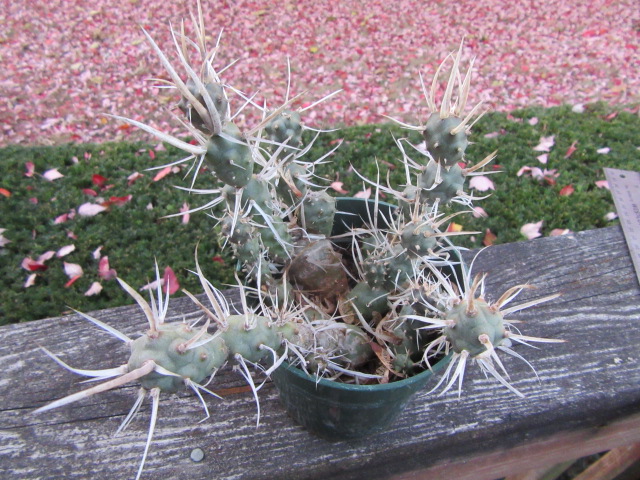
Tephrocactus articulatus var. papyracanthus (Paper Spine Cactus) on 10-23-23, #967-39.
With the segments falling off in years past, there is a nice little colony in the pot.
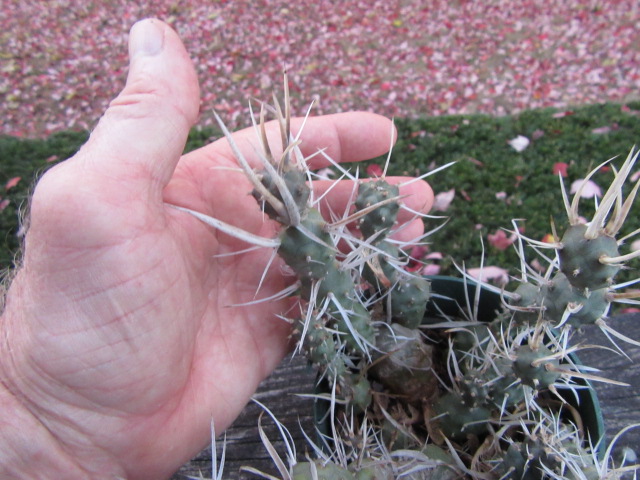
Tephrocactus articulatus var. papyracanthus (Paper Spine Cactus) on 10-23-23, #967-40.
This is a neat species that has been fun to watch grow. Just remember if you buy one, you need to handle it with care or the segments will fall off. Don’t forget about the glochids…
There isn’t much online about this cactus, but I will continue adding photos as time goes by and give as much information as I can from my experience. The Tephrocactus articulatus var. papyracanthus seems to be very easy to grow.
I hope you enjoyed this page and maybe found it useful. If you have any comments, questions, or suggestions, I would like to hear from you. Please click on “like” if you visited this page. It helps us bloggers stay motivated. 🙂 You can check out the links below for further reading. The links take you directly to the genus and species of this plant. If you see I have made an error, please leave a comment or email me at thebelmontrooster@yahoo.com.
I just picked one of these up, it has lovely thick paper spines that are darker at the base and unfortunately the little tufts of glochids as well.
LikeLiked by 1 person
That’s great! They are pretty neat little plants for sure and a great addition to any expanding cactus collection. Thanks for the comment and thanks for visiting!
LikeLike
I want to thank you for writing about your paper spine. There isn’t much on the web about them. I bought mine at the airport in Phoenix about a month ago. Just 2 sections and a little one budding. It’s growing well. Seems happy with all the heat here. The spines have grown longer and bud is bigger. Most interesting little guy.
LikeLiked by 1 person
Hello Barbe! The paper Spine is a very interesting cactus to grow for sure! I’m glad you found one and I am sure you will be happy with it. Thanks for visiting and thanks for the comment!
LikeLike
I’m on the other side of the world to you, bought one and it was unlabelled, like 2 years ago, LOL only just managed to ID it now. You’ve got a great blog there about it. Window sill full sun threw two new ‘cones’ after one year. One dropped but grew it on.
LikeLiked by 1 person
Hello there! Glad to hear from you! These are great plants and I am glad you found one. Take care and thanks for the great comment. Hope to hear from you again!
LikeLike